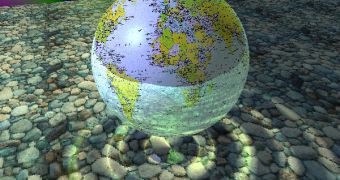Water gives our planet the name "Blue Planet".
This chemical gives life to Earth. The Earth's hydrological machine with its vertical cycle, from surface to atmosphere and from atmosphere to the surface, is driven by the Sun energy.
70,000 cubic km of water evaporate yearly from the ground, coming from rivers, lakes and plant and animal transpiration.
The seas and oceans contribute with 550,000.
The rainfall brings down this water amount: 440,000 on the seas and oceans and 110,000 on the ground, from where a great part is carried by rivers to the oceans and seas, while some amount reaches the water table that fuel the springs.
The underground water in the Earth is estimated to have a volume equal to the flow of all rivers for 132 years. A cloud contains up to 300,000 tonnes of water.
Our planet harbors a total of 1,359,000,000 cubic km of water, of which 97.5 % is stored in the seas and oceans, and just 2.5 % is freshwater. The rest is ice. Only the ice stored in Antarctica could fuel through its melting all the rivers on Earth for 800 years...
If the water cycle had been stopped, planet's freshwater reserves would be gone in just 14 days! The power of just one wave, measured in western France, was found to be about 75 million HP.
The seawater is estimated to contain, under the form of dissolved salts, the next amounts of elements: 2,000,000 tonnes of gold, 37,000,000 of silver, 100,000,000 of copper and 1,200,000,000 tonnes of manganese.
The total water amount found on the living organisms is estimated to 1,120 cubic km.
In plants, water may represent from 11 % (in dry grain seeds) to 75.3 % in raisin or even 97.66 % in cucumbers.
The trees consume huge amounts of water: 250 hectares of poplars absorb the same water amount yearly as that used by a 25,000-inhabitants town.
A medium cabbage transpires one water liter daily while a big tree up to 206.
A human being can resist about a month without food, but without water no more than 4 days...
About 9 million people die yearly due to diseases linked to the lack of clean water, like cholera or dysentery.
A drop of water with one millimeter in diameter 17 billion neutrons and up to 50 million bacteria, while the cleanest water contains at least 100 bacteria per cubic cm.
One liter of water contains a number of molecules equal to the Earth's weight expressed in kilograms.
Magnetized water stimulates strongly the development of crops, accelerates the technological processes in chemical industry, improves the qualities of the synthetic materials and concrete, impedes the deposit formations on the walls of the cauldrons, purges waste waters and desalinates salty terrains and decreases for several times colorant employment in the textile industry.
Besides heavy water, containing the heavy isotope of the hydrogen, researchers have made also water with the heavy isotope of the oxygen (O18), employed just in scientific research.
The oldest engineering machine known is an apparatus employed 5,000 years ago by the Sumerians for the water transport.

 14 DAY TRIAL //
14 DAY TRIAL //